|
||||||||||||||||||||||||||
 |
 |
|||||||||||||||||||||||||
|
|

|
|||||||||||||||||||||||
|
|
|
||||||||||||||||||||||
| 卡尔·奥尔夫 (Carl Orff,1895-1982) | |||||||||||||||||||||||
| 西蒙·拉特尔爵士指挥柏林爱乐演奏奥尔夫的《布兰诗歌》合唱。 | |||||||||||||||||||||||
布兰诗歌也称为 《博伊伦之歌》,原是舞台作品 《凯旋三部曲》中的第一部,作于1935—1936年, 1937年初演于法兰克福,后作为康塔塔迪先特博伊伦修道院中发现的一本13世纪的诗集。共分25个乐章,用女高音、男高音、假声男高音、男低音、童声合唱、合唱及乐队(内有14个乐章为管弦乐曲)。 |
|||||||||||||||||||||||
|
|
|||||||||||||||||||||||
|
音乐历史上的今天 1982年3月29日,卡尔·奥尔夫在慕尼黑他的家中去世,享年87岁。
卡尔·奥尔夫((Carl
Orff,1895年7月10日- 1982年3月29日,生于德国慕尼黑),德国作曲家,以其歌剧和戏剧作品以及在音乐教育方面的创新而闻名。
作为伟大的音乐教育家,他创建了独特的儿童音乐教学体系《奥尔夫教学法》。 |
|
||||||||||||||||||||||
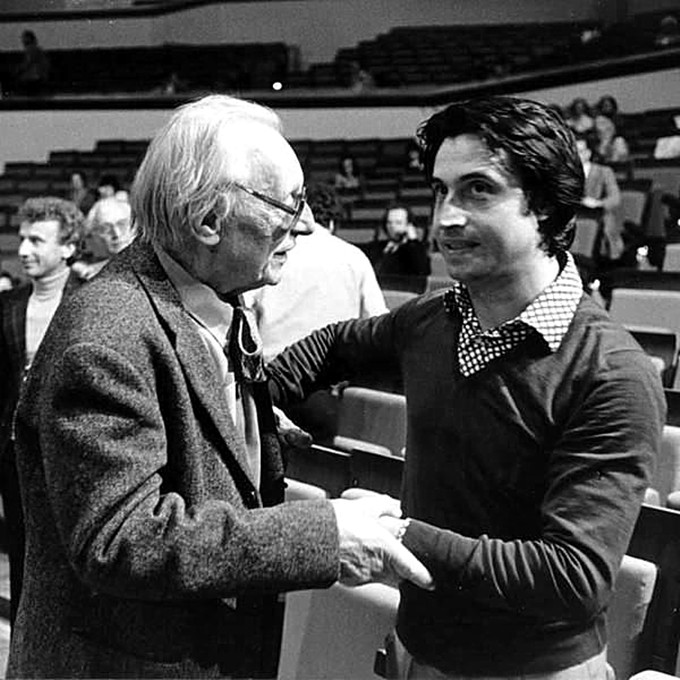 |
|||||||||||||||||||||||
| 奥尔夫和指挥家穆蒂在一起。 | |||||||||||||||||||||||
| Orff is with commander muti | |||||||||||||||||||||||
|
Today in the
history of music On March 29, 1982, Karl orff died at his home in Munich at the age of 87. Karl orff (born July 10, 1895 -- March 29, 1982, Munich, Germany) was a German composer known for his operatic and dramatic works and his innovations in music education. Orff studied at the Munich conservatory under German composer heinrich kaminski and later conducted in Munich, mannheim and darmstadt.His Schulwerk, a handbook describing his methods of conducting, was first published in 1930.Orff edited some 17th century operas and in 1937 wrote his secular oratorio camina branagh.The play is based on a manuscript of medieval poetry.This work led to other inspirations from Greek dramas and medieval mystery plays, notably Catulli carmina (1943;Song of catulus and trionfo of the African (1953;"The Triumph of Aphrodite," a trilogy co-written with Carmina Burana.His other works include the Easter cantata, Comoedia DE Christi comeback (1956);A birth drama, luddus north infante mirificus (1960);There are also three "musicals" - Antigone (1949), dilps DE terene (1959) and Prometheus (1966).Orff's system of musical education for children, based largely on developing a sense of rhythm through group practice and percussion, is now widely adopted.Together with German gymnast Dorothee Gunther, he founded the Gunther school of gymnastics, dance, and music in Munich in 1924. As a great music educator, he created a unique music teaching system for children, the orff method. Orff's teaching method is not aimed at gifted children, but at ordinary children."Almost all children have a natural musical sense and can receive music education."This is a firm belief formed by orff's lifelong practice of teaching children's music. Orff not only let the children enjoy music, but also let them sing and perform music activities by themselves, requiring a combination of music, dance, recitation, and body movements.One of the first emphasis is the training of the sense of rhythm, then gradually combined with the training of melody, harmony. The orff method was first formed in the gunter school in Munich in 1924.In the autumn of 1948, the radio station in byrne, Bavaria, broadcast the orff children's music textbook for five years.In 1950, the program was adapted into a school textbook, music for children (volumes 1-5). Since the orff institute was founded in 1961, it has promoted the adoption of the method around the world.More than a dozen countries have published the textbooks.In the first volume of the textbook, "song and instrumental ensemble", there are many pentatonic musical training, which Chinese children will find easier to adapt to. Today's video: 1. Sir Simon Rattle conducts the Berlin philharmonic for orff's duet of bran's poems;2. The opera 《Carmina Burana 》. |
|||||||||||||||||||||||
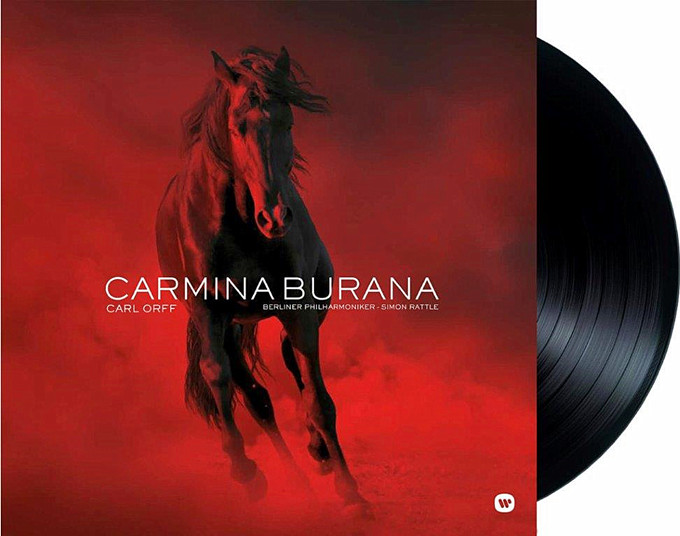 |
|||||||||||||||||||||||
| 布兰诗歌(Carmina Burana ) | |||||||||||||||||||||||
|
|
|||||||||||||||||||||||
|
《布兰诗歌》是一首歌词用拉丁文来描写爱情的歌曲,
分为3大部分:1.春,2.小酒店,3.爱情,演出时有哑剧动作,伴有丑角和舞蹈场面。此曲写作手法简单,摒弃了常用的对位、主题发展、变奏等,而是用同度,八度,三度的声部进行,句段多重复,
是一部音效极佳的作品, 经常被影视作品所引用。 Burana——在德国慕尼黑南部阿尔卑斯山谷中上巴伐利亚州的小镇贝内迪克特,有一所始建于公元740年的古老修道院--布兰修道院。由于偏僻和隐秘,很少受到战乱和其它天灾人祸的破坏,因而保存着许多具有重要价值的历史文献。1803年,考古学家在这所修道院中发现了大量中世纪诗歌和戏剧古卷,其创作时间大约在11至13世纪,在内容上可以分为宗教和世俗两类,其中的两百多首作者不详的世俗诗歌经巴伐利亚的学者整理出版,这就是《Carmina Burana 布兰诗歌》。 这些大部分用拉丁文写成的诗歌显然出自神职人员和落魄文人以及流浪学生的手笔,其中蕴含的放荡不羁的精神和对放浪形骸的生活方式的赞美以及对封建社会的无情嘲讽都令人惊讶。毫无疑问,这些被称作"中世纪的拉丁抒情诗"的作品出现在以基督教文化为中心的时代,不能不说是一个奇迹。 1935年,奥尔夫读到了这部诗集,这使一生从事音乐教育工作的奥尔夫,在时空的某一个点上找到了时间的联系。他的冲动,在阅读完这本诗集后,形成了一种对人类与自身命运的思考。因此冲动而成就的这一部"为独唱者、合唱队、器乐伴奏和魔幻布景而作的世俗歌曲",他将它称为"情景康塔塔",并且要求以舞台作品的方式演出。 1937年6月8日,《Carmina Burana布兰诗歌》在法兰克福首演。当时的德国,由勋伯格、韦伯恩、贝尔格等人限定了一种现代音乐语言——十二音列。不仅是音乐界的焦点,更间接或直接地影响了当时所有的现代音乐。而奥尔夫作为一个儿童音乐教育家,在他与友人D·京特合办"京特体操—音乐—舞蹈学校",探求音乐与语言动作的结合及各种打击乐的配合,写成《教学作品》,创建独特的儿童音乐教学体系后,已经掌握了自己的音乐语言。 奥尔夫说过:"音乐表现越是本质、单纯,效果也就越直接、强烈。" 奥尔夫的美学思想就是简朴、单纯。 他偏爱强烈、明快的节奏,认为节奏是一切音乐的开始。他使用最原始,最简单的节奏,不断反复,用尽之后才换另一节奏。他的节奏干脆,利落,不重视和声行进,不属于动力型,属静态型。在整部康塔塔中,激荡人心强健有力的节奏扮演了重要的角色。 他的旋律由短小动机连续不断地反复而成,不用模进,不用变奏,没有表情的因素,没有明确的特性,只有通过歌词、节奏、伴奏才能理解。在《Carmina Burana 布兰诗歌》中的旋律语言包罗较广,从单旋律歌曲、民间歌曲到弗拉曼戈歌曲和浪漫歌剧,面貌多姿多彩。 他的和声多用一级和五级和弦,大多为同度、八度、三度、五度,几乎不用半音。只有在惊叹句的时候才会用一下不协和和弦。 他的曲式有两种主要风格: 1,Antiphon 对唱性的赞歌,对答合唱,交错进行。 2,方块型 没有发展、变奏,不断反复。 他的配器以打击乐为主要风格,三管编制的大型乐队,加打击乐加钢琴,有时候,整个乐队都会被他当作打击乐来使用。 在多半是艰涩难懂的20世纪严肃音乐中,《Carmina Burana 布兰诗歌》的纯朴、生动显得很不合群。但我想它也许是本世纪最好听的合唱曲之一了。 |
|
||||||||||||||||||||||
|
Bran's
poem is a song with Latin lyrics about love, divided into three
parts: 1. Spring, 2. Tavern, 3. Love, pantomime action,
accompanied by clowns and dancing scenes.The writing technique
of this song is simple, which abandons the commonly used
counterpoint, theme development, variation, etc., but USES the
same degree, octave, three degrees of the voice part, sentence
paragraph repetition, is a sound excellent works, often cited by
film and television works. Burana - in the alpine valley south of Munich, in the German town of benedikot in upper Bavaria, there is an ancient monastery, the monastery of brann, founded in 740 AD.Because of its remoteness and privacy, it is seldom damaged by wars and other natural and man-made disasters, so it keeps many valuable historical documents.In 1803, archaeologists have found a lot of the middle ages in the monastery scrolls, poetry and drama, its creation time at about 11 to 13 century, in content can be divided into two categories, religious and secular, more than two hundred of them unknown authors secular poetry by the Bavarian editing and publishing of scholars, that is "Carmina Burana brent poetry". The poems, most of them written in Latin, are clearly the work of clergy and outcast literati, as well as of wandering students. The spirit of debauchery, the celebration of a Bohemian way of life, and the merciless mockery of feudal society are surprising.There is no doubt that these so-called "Latin lyric poems of the middle ages" were a miracle in a time when Christian culture was central. In 1935, orff read this poem, which made orff, who had been engaged in music education all his life, find the connection between time and space at a certain point.His impulse, after reading this book of poems, formed a reflection on human beings and their own destiny.This impulsive "secular song for the soloist, the chorus, the instrumental accompaniment, and the magical setting," he called it "the cantata of the scene," and demanded that it be performed as a stage work. On June 8, 1937, "Carmina Burana bran poems" premiered in Frankfurt.In Germany at that time, schoenberg, webern, berge and others defined a modern musical language -- the 12-tone series.Not only the focus of the music industry, but also indirectly or directly influenced all the modern music of the time.Orff, as a children's music educator, founded an independent teaching work after he and his friend D gunter jointly organized the "gunter gymnastic - music - dance school", which explored the combination of music and language movements and the cooperation of various percussion music Vinyl: poetry by orff bran Vinyl: poetry by orff bran After the special children's music teaching system, has mastered its own music language. Orff said, "the more essential and simple the music, the more direct and intense the effect." Orff's aesthetic thought is simple and simple. He preferred a strong, lively rhythm, believing that rhythm was the beginning of all music.He used the most primitive and simple rhythms, repeated them over and over again, and then changed to another rhythm after he had exhausted them.His rhythm is crisp and crisp, he doesn't pay attention to harmony, he's not dynamic, he's static.Throughout the cantata, the stirring and powerful rhythm plays an important role. His melodies are made continuously and repeatedly by short motives, without any mold or variation, without the element of expression and without specific characteristics, which can only be understood through lyrics, rhythm and accompaniment.The melodic language in "Carmina Burana" includes a wide range of melodic songs, folk songs, flamango songs and romantic operas. His harmonies are mostly one - and five-degree chords, mostly the same degree, octave, third degree, fifth degree, and almost no semitones.Dissonant chords are used only in exclamations. There are two main styles of his forms: 1. Antiphon's antiphonic hymn, chorus, interlaced. 2. There is no development or variation of the square, and it is repeated repeatedly. His orchestration was mainly percussion, a large band of three pipes, plus percussion and piano, and sometimes the whole band was used as percussion by him. The simplicity and vividness of "Carmina Burana" is a misfit in the largely esoteric, serious music of the 20th century.But I think it's probably one of the best choral songs of the century. |
|||||||||||||||||||||||
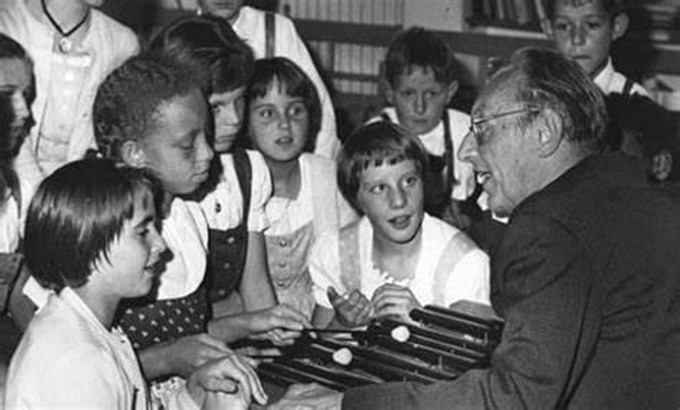 |
|||||||||||||||||||||||
| 1970年7月7日——75岁的卡尔·奥夫教授:1970年7月10日,卡尔·奥夫教授将庆祝他75岁的生日。这位出生于慕尼黑的作曲家,是其他作曲家的学生。卡明斯基因其舞台表演《卡里姆娜·布拉纳》(1937)和歌剧《月亮》(1939)、《聪明的万》(1942)而出名。《安提戈涅》(1949年),《俄狄浦斯的暴君》(1959年),奥夫把他的教育思想写进了他的《学校作业》。在他看来,孩子们应该从4岁开始接受音乐和节奏的基础教育,从而为以后的音乐或舞蹈教育打下基础。图片显示,卡尔·奥尔夫教授在孩子们的簇拥下,为“奥尔夫学校”的新校舍剪彩。(图片来源:Keystone Pictures USA/ZUMAPRESS) | |||||||||||||||||||||||
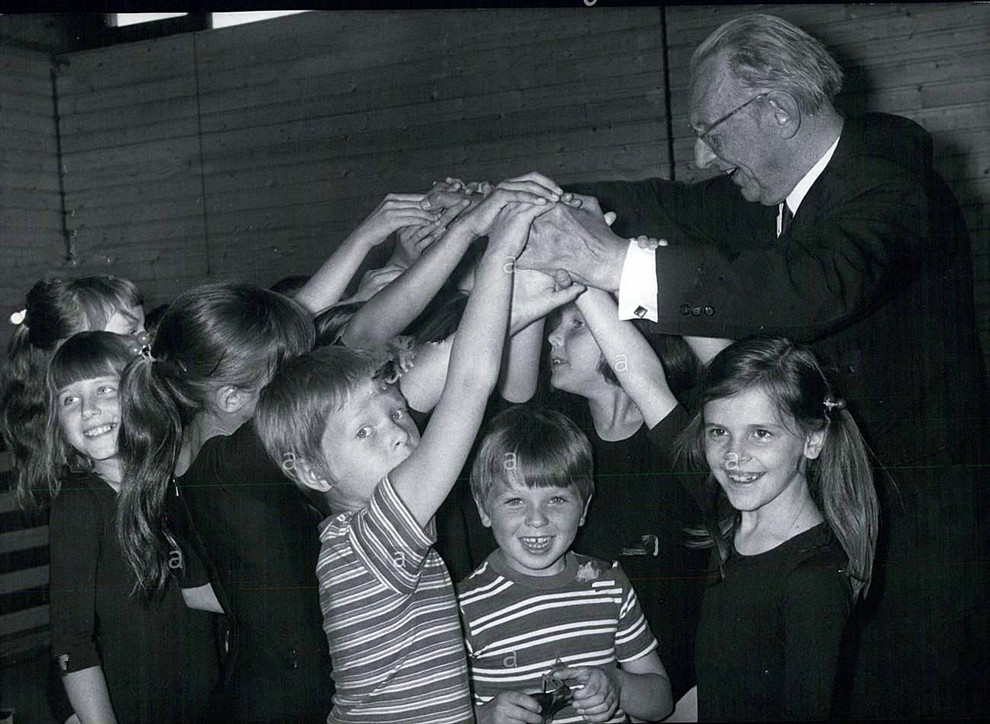 |
|||||||||||||||||||||||
| Jul. 07, 1970 - Professor Carl Orff 75 year old: On July 10th, 1970, Professor Dr. hon. Carl Off will be celebrating his 75th birthday. This Munich born composer, a student of, among others. H. Kaminski has become famous with his stage cratoric ''Carimna Burana'' (1937) and the Operas ''The Moon'' (1939), ''The Smart Wan'' (1942) ''Antigone'' (1949), ''Oedipus the Tyrant'' (1959) His pedagogic ideas Orff has put down in his ''School Work''. To his mind children should get an elementary instruction in music and rhythm, starting with the age of 4, thus gaining the basis for a later education in music or dancing. Photo shows Professor Carl Orff, surrounded by Children, on the occasion of the opening of a new house for the ''Orff School' (Credit Image: Keystone Pictures USA/ZUMAPRESS) | |||||||||||||||||||||||
|
|
|||||||||||||||||||||||
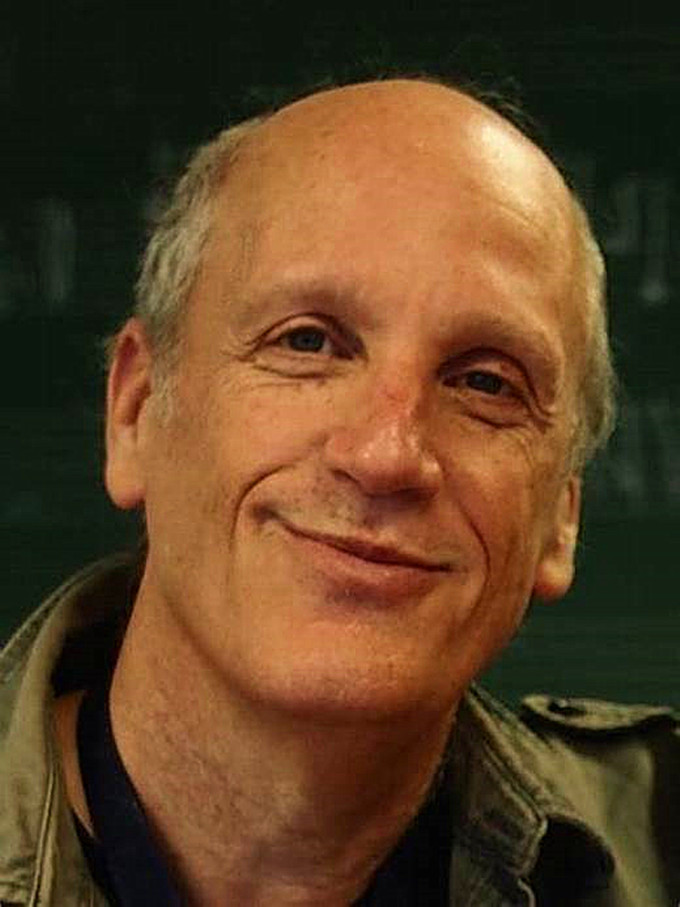 |
|||||||||||||||||||||||
| 道格·古德金(Doug Goodkin) | |||||||||||||||||||||||
|
教所有年龄的学生音乐 “他的作品传达了一种长期的、认真的、持续的奋斗,以一种肯定我们集体人性的方式来呈现正直的音乐。”~以前的学生 道格·古德金(Doug Goodkin)目前在旧金山这所学校任教45年,他在该校教三岁到八年级的儿童音乐和运动。他定期为美国和加拿大各地的 奥尔夫分会举办讲习班,并在州和全国性会议上发表演讲。 道格是在音乐教育方面的八本书的作者:一个押韵,游戏名字,声音的想法(Alfred酒吧),玩,唱歌跳舞:介绍奥尔夫Schulwerk (Schott),现在的时间:教爵士所有年龄和Intery Mintery:童谣的身体,声音和奥尔夫合奏(五声的出版社),入门教育:一个引物对学校(五声的出版社)和他最近出版的所有布鲁里爵士乐:奥尔夫的爵士乐合奏。 《学校音乐》(Orff Schulwerk)是作曲家卡尔·奥尔夫和他的同事古尼尔德·基特曼创造的一种音乐和运动教育的动态方法。从每个孩子天生的音乐天赋出发,奥尔夫方法通过游戏、圣歌、歌曲、运动、民间舞蹈、戏剧和专为初学音乐的孩子设计的奥尔夫乐器,把它带进孩子的世界。 道格·古德金是一位音乐教育家,也是奥尔夫·舒尔沃克的支持者。在他40年的音乐教学生涯中,他对教育的愿景是满足每个孩子的想象力、精神和人道主义承诺。 |
|||||||||||||||||||||||
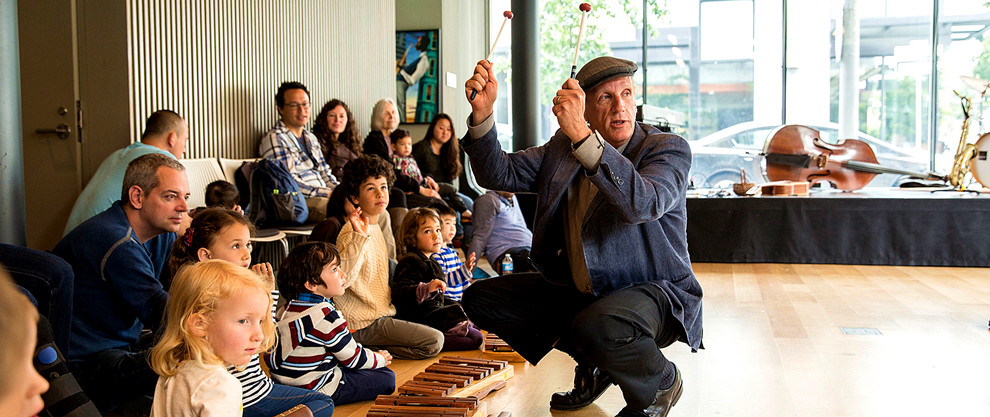 |
|||||||||||||||||||||||
|
Teaching
Music to All Ages "His work work conveys a long, earnest and continuing struggle to present music of integrity in a way that affirms our collective humanity." ~ Former Student Doug Goodkin is currently in his 45th year at The San Francisco School, where he teaches music and movement to children between three years old and eighth grade. He regularly gives workshops for Orff Chapters throughout the U.S. and Canada, as well as presenting at State and National Conferences. Read More About Doug... Doug is the author of eight books on music education: A Rhyme in Time, Name Games, Sound Ideas (Alfred Pub.), Play, Sing and Dance: An Introduction to Orff Schulwerk (Schott), Now's the Time: Teaching Jazz to All Ages and Intery Mintery: Nursery Rhymes for Body, Voice and Orff Ensemble (Pentatonic Press), The ABCs of Education: A Primer for Schools to Come (Pentatonic Press) and his recently published All Bues: Jazz for the Orff Ensemble. Visit Pentatonic Press... Orff Schulwerk is a dynamic approach to music and movement education created by composer Carl Orff and his colleague Gunild Keetman. Proceeding from a strong conviction in each child's natural musical promise, the Orff approach draws it forth through the child's world of games, chant, song, movement, folk dance, drama and work on specially designed Orff instruments just right for the beginning musician. Learn More About Orff... Doug Goodkin is a music educator and proponent of Orff Schulwerk. His vision of an education that meets the imaginative, spiritual and humanitarian promise of each child was formed during four decades of teaching music. |
|||||||||||||||||||||||
|
|
|||||||||||||||||||||||
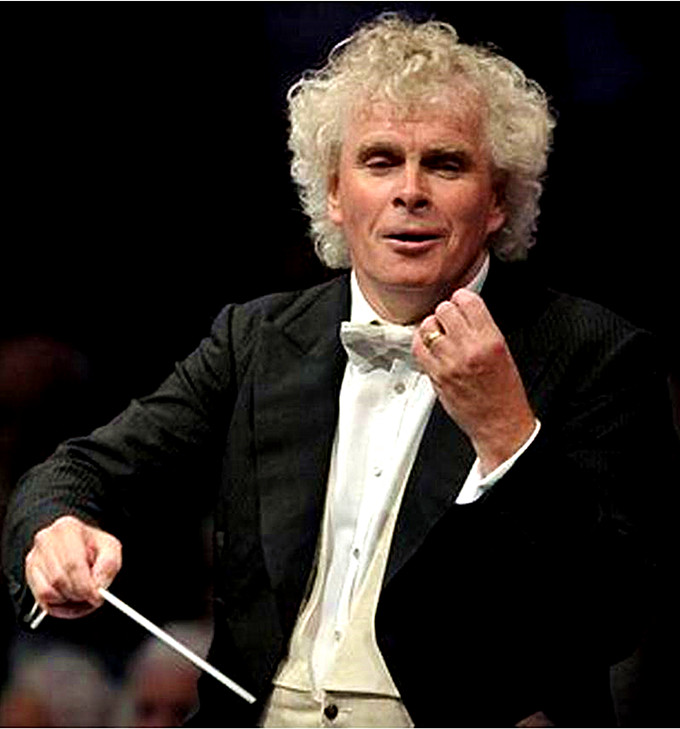 |
|||||||||||||||||||||||
| 西蒙·拉特尔爵士在指挥中(Sir Simon Rattle ) | |||||||||||||||||||||||
|
西蒙·拉特尔(Simon
Rattle),1955年1月19日出生于英国利物浦,英国指挥家。 1970年,与利物浦皇家爱乐乐团合作,举行了首场交响音乐会。1971年,进入伦敦皇家音乐学院学习指挥 。1974年,在英国伯恩茅茨举行的约翰·普莱尔国际指挥比赛中获得冠军,奠定职业指挥家的基础。1979年迎来事业转折,受聘担任伯明翰市立交响乐团的常任指挥 。1981年,被洛杉矶爱乐乐团聘为首席客座指挥。1987年,与伯明翰市立交响乐团合作录制马勒《第二交响曲》,并于同年首次执棒柏林爱乐乐团。1993年,被英国政府、《留声机》杂志授予年度艺术家称号。1994年,被英国女王授予爵士头衔 。1997年,被BBC音乐杂志授予“最佳音乐家成就奖”。1999年,与维也纳爱乐乐团合作的《贝多芬钢琴协奏曲全集》获法国唱片大奖。2000年,联合国教科文组织将他选为“和平艺术家” 。 2002年,正式成为柏林爱乐乐团的首席指挥 。2003年,当选为德国古典回声奖“年度最佳指挥” 。2009年,开始推广柏林爱乐的“数字音乐厅”;同年,荣获格莱美“最佳合唱表演奖” 。2012年,被列入《留声机》杂志“名人堂”名单。2017年,出任伦敦交响乐团音乐总监 。 |
|||||||||||||||||||||||
|
Simon Rattle was born on January 19, 1955 in
Liverpool, England. In 1970, in collaboration with the Liverpool royal philharmonic orchestra, the first symphony concert was held.In 1971, he entered the royal college of music in London to study conducting.In 1974, he became a professional conductor by winning the John pryor international conductor competition in bournemouth, England.1979 marked a turning point in his career when he was appointed permanent conductor of the Birmingham city symphony orchestra.In 1981, he was hired as principal guest conductor by the Los Angeles philharmonic orchestra.In 1987, he recorded mahler's second symphony with the Birmingham city symphony orchestra and made his Berlin philharmonic debut in the same year.In 1993, he was named artist of the year by the British government and gramophone magazine.He was knighted by the queen of England in 1994.In 1997, he was awarded the "best musician achievement award" by BBC music magazine.In 1999, the complete works of Beethoven's piano concerto with the Vienna philharmonic orchestra won the French recording award.In 2000, UNESCO selected him as an "artist of peace". In 2002, he became the principal conductor of the Berlin philharmonic orchestra.In 2003, he was named conductor of the year by the German classical echo award.In 2009, it began to promote the Berlin philharmonic's "digital concert hall";In the same year, he won the grammy award for best chorus performance.In 2012, he was inducted into the gramophone magazine's hall of fame.In 2017, he became music director of the London symphony orchestra. |
|||||||||||||||||||||||
卡尔.奥尔夫《布兰诗歌(博伊伦之歌)》_歌剧,更新p2p3带字幕版 |
|||||||||||||||||||||||
|
|
|||||||||||||||||||||||
| 更多奥尔夫信息扩展链接 | |||||||||||||||||||||||
| 奥尔夫教学体系 | |||||||||||||||||||||||
| 新千年的奥尔夫音乐教育 | |||||||||||||||||||||||
|
|
|||||||||||||||||||||||
| 未得原作者编者授权严禁转载www.mt77.com任何内容 | |||||||||||||||||||||||
|
|
|
||||||
|
copyright © 2003-2005 xilu.com all rights reserved. |
||||||
|
|
||||||













